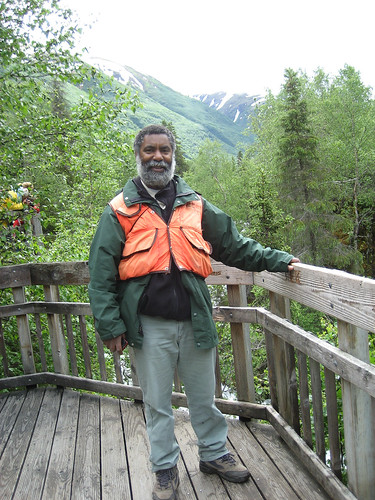
To be a wildlife biologist and to be in Alaska … it’s not a question, it’s the good life for this Forest Service land manager.
Just ask Robert Stovall, the deputy district ranger for the Seward Ranger District since 2009 for Alaska’s Chugach National Forest. There are no roads into the forest’s interior. Beyond a two to three-mile road journey, you’ll find yourself in back country with no improved roads, a land full of beautiful scenery, lots of native wildlife, adventures and challenges.
Stovall is engaged in managing the various resources on the district and assists with overall forest management activities such as the effects of a large bark beetle outbreak 10 years ago that today involves restoring about a third of the district. As a line officer focused on managing the agency’s multiple use mission, he feels he’s found his niche.
“The opportunity to focus on programs that involve multiple resources is very rewarding,” said Stovall. “It’s the chance to work in timber, minerals, fire programs, wildlife and fisheries, heritage, and watersheds which involve working with interdisciplinary teams to help guide the projects.”
Stovall has spent his 35-year career as a land management steward for national wildlife refuges and national forests across the nation. During that time, he’s experienced some of the most soul-refreshing and adventure-inspiring scenery, beheld eye-to-eye encounters with moose and bear, weathered the vagaries of changes in Alaska’s yearly snowfalls, and helped residents and visitors enjoy their national lands.
Part of his focus is also helping the next generation learn to appreciate the many ways to enjoy getting outside. The forest is known as the Chugach Children’s Forest which provides opportunities for outdoor educational activities and expeditions to help children learn about nature.
“We’re working with schools and other young adults and youth-oriented employment groups,” he said. “This is very important because these folks are eventually going to be doing my job and I love to see them get interested in doing my job the way I did by going out and being in the woods.”
One of those activities involved exploring a snowfield that was used by native Alaskans in prehistoric times. Stovall accompanied a youth expedition for an ice patch survey which involved a 10-mile horseback ride to the edge of ice fields on Devil’s Creek Trail to look for prehistoric signs of hunted caribou. While the kids learned more about their culture, Stovall experienced a different kind of adventure.

“With a steep drop off, you kind of want the horse to hug the inside of the trail. For the old rangers of 1910, 1920 or 1930, it was their standard operating procedure to ride a horse,” he said. “Fast forward 100 years and I’m there getting on a horse for the first time in my life, and for me, it was not one of those experiences I was immediately ready to repeat. This particular ranger was kind of astounded by it. I’m glad I can say that I’ve done it.”
Fishing is a major industry and recreational activity on the Chugach. A world-renowned fishery for sockeye salmon sits on the clear waters of the district’s Russian River where sportsmen can see the fish and a personal use fishery is located on the lower portions of the Kenai River, the major river on the Kenai Peninsula which flows out of the glacially-fed Kenai Lake. Dip net fishing with a four to five-foot diameter net is popular with fishermen who stand in the river and wait for the fish to swim into the net. One of Stovall’s hobbies is mastering the joy of ‘catching the big one.
“My favorite pastime is of course fishing, especially salmon fishing. Fishing for silvers, also known as coho, salmon fishing is probably the most fun because they bite at the lures, they’re a big fish, and they’re relatively aggressive,” said Stovall. “They’re not an easy fish to catch unless you have a lot in an area and you can use a snagging hook method to make them easier to catch.”
When he’s not fishing, he’s exploring the trail system for hiking, biking and bird watching, nervously watching for black and brown bears while fishing, and watching the wildlife.
“As a wildlife biologist, I think moose are probably the most stunning animal to observe. It’s amazing how an animal that large can all of a sudden be right before you. You come around a corner and there’s a moose. Your first instinct is to run, which if you have to do it, run in a zigzag fashion,” he cautioned. “Remember, with a bear just back away or let it go where it wants to go and then you go somewhere else.”
The Chugach was also chosen as this year’s national forest to provide the Capitol Christmas Tree and it will most likely come from the Seward Ranger District.
Read more about Stovall in FACES of the Forest, a feature that introduces the people, places and professions in the agency.

